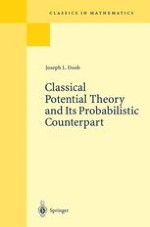2001 | OriginalPaper | Buchkapitel
Brownian Motion on the Martin Space
verfasst von : Joseph L. Doob
Erschienen in: Classical Potential Theory and Its Probabilistic Counterpart
Verlag: Springer Berlin Heidelberg
Enthalten in: Professional Book Archive
Aktivieren Sie unsere intelligente Suche, um passende Fachinhalte oder Patente zu finden.
Wählen Sie Textabschnitte aus um mit Künstlicher Intelligenz passenden Patente zu finden. powered by
Markieren Sie Textabschnitte, um KI-gestützt weitere passende Inhalte zu finden. powered by
Let D be a connected Greenian subset of ℝN, let K be a Martin function for D, let h be a strictly positive superbarmonic function on D, and let {wξh(·), ℱξh(·)} be an h-Brownian motion in D from ξ with lifetime Sξh. For A a subset of D let SξhA and LξhA, respectively, be the hitting and last hitting times of A by wξh(·). According to Theorem l.XII.10, if h is harmonic, the Martin boundary is h-resolutive and μ D h(ξ, dζ) = K(ζ, ξ)M h (dζ)/h(ξ), where M h is the Martin representing measure of h corresponding to K. According to Theorem II.2, the left limit wξh(Sξh−) exists almost surely and has distribution μ D h(ξ, ·) supported (Section l.XII.7) by the minimal Martin boundary ∂1mD. In particular, if ζ is a minimal Martin boundary point and if h = K(ζ, ·), then μ D h(·, {ζ}) = 1; so wξh(Sξh−) = ζ almost surely. With this choice of h we shall sometimes write wξζ(·), SξζA, LξζA, respectively, for wξh(·), SξhA, LξhA.
